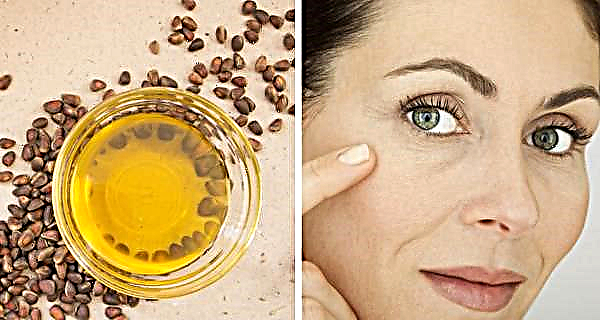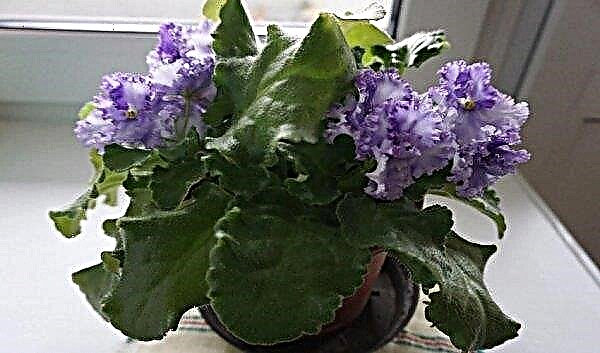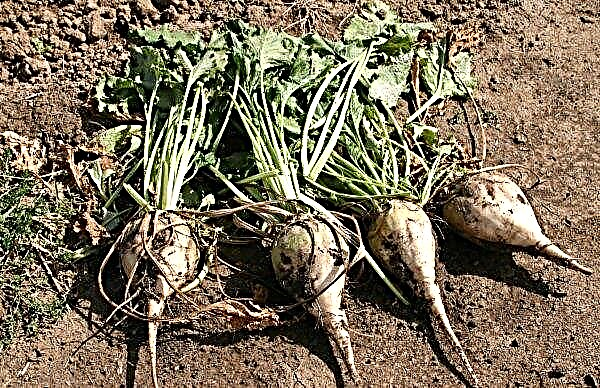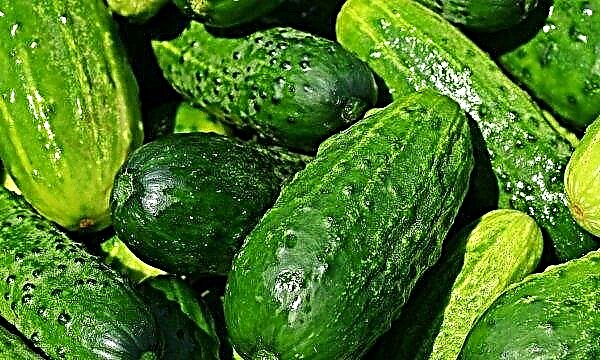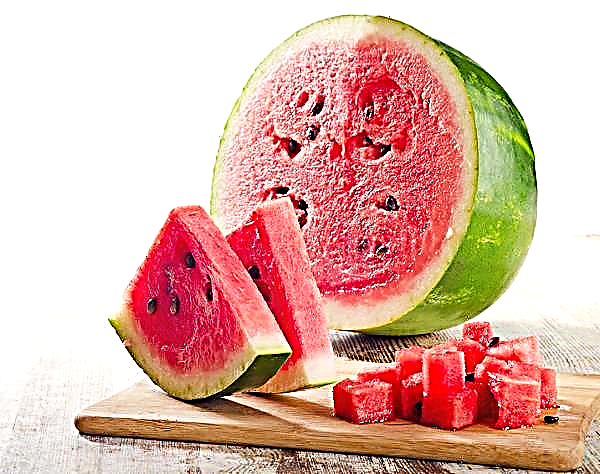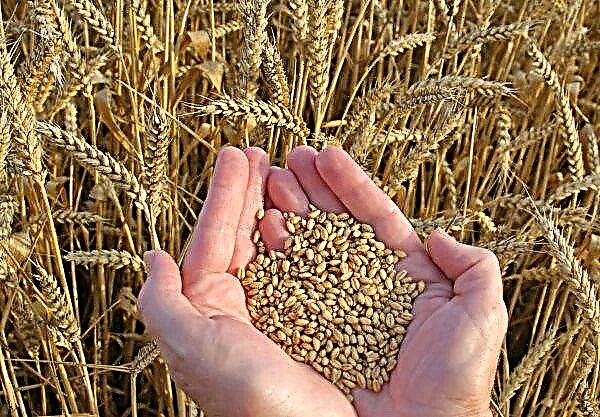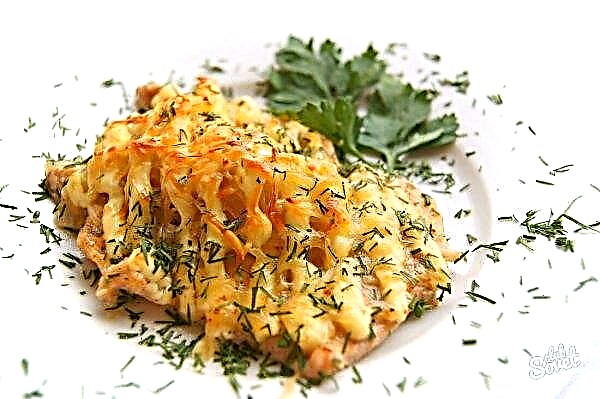Everyone knows about the benefits of garlic from early childhood, because along with onions, it is considered an excellent prophylactic during colds. In addition, our grandmothers also revealed its unique ability to withstand the effects on the body of pathogens and parasites (including worms), so the relevance of its use remains high today. Let's learn more about this fragrant plant and consider several ways to harvest it for the winter.
The effect of garlic on the human body
Garlic has a whole set of useful properties, and there is practically no difference, we are talking about a fresh or canned product in accordance with all the rules. According to some reports, the fragrant cloves of this plant successfully fight even with cholera and typhoid, and all thanks to the phytoncides present in them. To make sure the relevance of such a product on your table, it is worth learning about all its useful properties and take into account possible contraindications for use.
Benefit
Few people know, but garlic is a very nutritious product containing 100 grams of 149 kcal, 31 grams of carbohydrates, 6.4 grams of protein and 0.4 grams of fat. In addition, it contains mineral components (in particular, potassium, calcium, iron, phosphorus, magnesium, iodine, zinc), vitamins B, C, P, D, as well as sulfur compounds, essential oils and volatile oils.
- Together with other garlic components, these elements have a beneficial effect on various organs and systems of the human body, expressing their influence in:
- successful fight against pathogens of typhoid, dysentery, staphylococcus;
- antitumor activity (in particular, preventing the development of prostate cancer in men);
- lowering blood glucose and cholesterol levels;
- prevention of blood coagulation and thrombosis;
- elimination of the effects of stressful conditions;
- improving the condition of the throat and the resumption of the voice, which is especially important for pulmonary asthma and partial paralysis of the face;
- normalization of the functioning of joints, spleen, gastrointestinal tract;
- antimicrobial, antispasmodic and diuretic effects.
Did you know? As a culture, garlic began to be grown 5,000 years ago, and before that, it grew only in open nature.
Harm
Garlic can only harm if a person ignores contraindications to its use. Despite the fact that there are not so many of them, it is impossible to ignore such features.
- First of all, people should avoid eating plants:
- suffering from kidney failure and other problems with this body;
- having problems of the digestive tract, in particular ulcers, gastritis and cholelithiasis;
- prone to allergic manifestations (especially if an allergy to garlic has already manifested).
Features of the choice of products for the recipe
If you decide to preserve garlic for the winter, then you must first choose the main ingredient - juicy and fresh heads. A soft product with no pronounced aroma is generally not suitable for cooking, and when preserved, it can change its color to blue or green. This also applies to varieties of red garlic, although this feature will not affect the beneficial properties of the heads. For easy cleaning of large garlic heads, it is advisable to blanch them, first dipping them in boiling water for 20 seconds and then cooling them in cold. Also pay attention to the dishes in which the marinade will be prepared. The best is Teflon, glass or ceramic saucepan, while in copper garlic it will turn green or blue.
For easy cleaning of large garlic heads, it is advisable to blanch them, first dipping them in boiling water for 20 seconds and then cooling them in cold. Also pay attention to the dishes in which the marinade will be prepared. The best is Teflon, glass or ceramic saucepan, while in copper garlic it will turn green or blue.
How to Make Pickled Garlic
If you do not take into account the wide list of possible ingredients for the preparation of pickled garlic for the winter, then by the method of creation all such preparations can be divided into two groups: preservation of garlic cloves and whole heads. Both options have their advantages, so we offer you two recipes.
Important! To get a healthy harvest of red garlic, you should choose recipes for conservation with beets.
Recipe 1 (heads)
To harvest whole garlic, you will first of all need large or medium-sized garlic heads themselves, spices, apple cider vinegar, paprika pods and certain herbs. The full list of necessary products in this case will look like this:
- young garlic heads on the “leg” - 1300 g;
- hot pepper - 1 pod;
- dill umbrellas - 1 branch;
- horseradish leaves - 1-2 pieces;
- apple bite - 100 ml;
- currant and cherry leaves - 3-4 leaves;
- black allspice, peppercorns, coriander and cloves - 10 each.
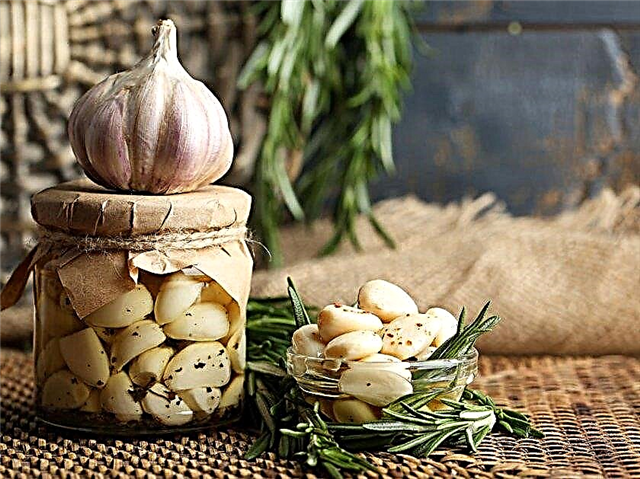 From the kitchen equipment you will need only a glass container with clean hot water, a pot for preparing brine and sterilized jars. The procurement process consists of the following steps:
From the kitchen equipment you will need only a glass container with clean hot water, a pot for preparing brine and sterilized jars. The procurement process consists of the following steps:- Peel the garlic by removing the upper skin from it and cutting off the lower antennae (you can cut them under the very head).
- Prepare a brine: 2 full tbsp. Should be in 1 liter of boiling water. tablespoons of salt and one same spoonful of sugar, black pepper, coriander and other cooked spices that you just need to pour into boiling water. Bring the resulting mixture to a boil and do not remove from the stove for 5-10 minutes.
- Fill the jar with garlic and herbs. First put a piece of horseradish on the bottom of the sterilized jar, and on top of it lay garlic in a random order (be sure to spine up). Each layer of garlic should be alternated with dill umbrellas, cherry and currant leaves, slices of chopped hot pepper, filling the jar to the very top.
- Pour boiling water over the garlic and let it sit for 5 minutes. After the specified time, drain boiling water.
- Pour apple cider vinegar into a jar, and then fill with boiling brine to the top.
- Roll up the jar with a sterilized metal lid or close the steamed nylon. After cooling, the container can be removed to the pantry.
Video: how to pickle garlic heads for the winter
Recipe 2 (cloves)
The preservation of garlic with teeth takes a little longer than its harvesting with heads, but for the most part this is due only to an increase in the time of cleaning the plant. In addition to peeled garlic prongs (take 350 g, which will be enough for one half liter jar) you will need:
- pure water - 250 ml;
- dill umbrella - 1 piece;
- bay leaf - 1 piece;
- black pepper - 5 peas;
- cloves - 1 piece;
- sugar - 1 tbsp. the spoon;
- salt - ½ tbsp. spoons;
- vinegar (9%) - 3 tbsp. tablespoons, or 35 ml.
Did you know? The strong smell of garlic served as the main reason for giving the plant supernatural powers. For example, in the mythology of the ancient Slavs, it was considered a strong guard against vampires and many demons.
The pickling process in this case does not differ in increased complexity, the main thing is to adhere to the staging of all tasks:
- First, rinse the garlic cloves well and let the water drain.
- Sterilize the prepared jar with a lid.
- Put the garlic cloves in a glass bowl.
- Prepare the brine (pour water into the pan, add salt, sugar, dill umbrellas, spices and put on the stove, and after boiling the mixture, add vinegar to it).
- Pour the garlic with a pickle, put the bay leaf and boiled dill on top, roll it with a metal lid.
- Turn the jar upside down and wrap it with a towel.
- After the brine has cooled completely, you can put the can in the refrigerator.
Video: how to pickle garlic with cloves for the winter
Rules for storing blanks
Pickled garlic will be fully prepared no earlier than 15-30 days from the date of preservation, therefore it is advisable to take a sample from your creation after 1-1.5 months. Closed and sterilized cans can be stored in room conditions, but only in a dark and dry place (for example, in a pantry), but opened containers are best kept in the refrigerator. At a high temperature in the room and the closed preservation is taken out to the basement, especially if the jars are not additionally boiled, and the garlic is simply covered with oil or marinade. The shelf life of such a product is about three months, although there are often cases when the workpiece is well preserved for up to six months.
At a high temperature in the room and the closed preservation is taken out to the basement, especially if the jars are not additionally boiled, and the garlic is simply covered with oil or marinade. The shelf life of such a product is about three months, although there are often cases when the workpiece is well preserved for up to six months.
Important! Do not allow sharp freezing of seals. Slow cooling of jars prevents spoilage and fermentation of their contents.
Additional tips
The success of any business depends on the subtleties and nuances of performing all the actions, so even such a simple task as preserving garlic has some important features:
- To improve the taste of the finished product and facilitate its cleaning, it is advisable to soak the prepared cloves for several hours in warm water, which will help soften the husk.
- For preservation, it is advisable to choose small jars, because if the snack turns out to be very spicy, you will often not want to use it.
- Separate teeth are prepared faster than whole heads, which significantly affects the minimum shelf life of the workpiece before it is used.
- When choosing products, it is worth giving preference to specimens grown on beds, since store garlic quickly darkens when canned.
- Sterilization of cans is a prerequisite when preparing for a roll, but it is not necessary to process them with boiling water or steam: a microwave oven will help to speed up the process.
- It is better not to sterilize rolled garlic cans or perform this procedure for a relatively short time, so that the components of the container do not lose their taste and aroma.
- To give preservation an interesting and original look, you can add beet juice to the jar, and the more it is, the more saturated the color of the finished product will be.
Pickled garlic is a great option for seals for young housewives who have not yet been conserving. The simplicity of all actions and a good end result will be a great start on the path of preserving vegetables and fruits for the winter.

